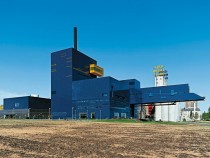
© Roland Halbe
In 1963, Tyrone Guthrie founded a theatre on European lines in Minneapolis. The “Guthrie”, as it was known, became one of the most important theatres in the US, but forty years later, the old building was too small for the many functions it had to accommodate. To counter the advancing desolation of its inner-urban areas, Minneapolis, like other US cities, has erected a number of buildings for the arts, and the new Guthrie Theatre can be seen in this context. The site chosen was a former grain distribution area on the banks of the Mississippi. The new complex contains an arena-like auditorium – as in the previous building – as well as a rectangular theatre space and a small studio stage. In 2001, Jean Nouvel was entrusted with the planning. His concept proposed three auditoriums raised above the ground to afford visitors a view over the largely industrial riverscape. A 53-metre-long cantilivered arm and a series of vertical and horizontal cubic volumes conjure associations of industrial buildings like the huge grain silos nearby.






